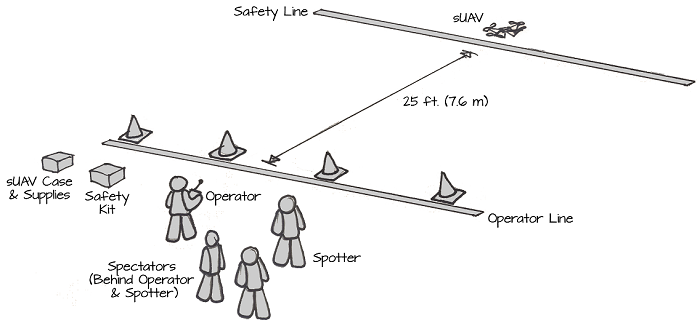Guidelines for Flying Outdoors
Flying outdoors provides you with much more open space to fly, but it also comes with a number of variables that are harder to control. Special care must be taken to make sure that the outdoor area you are flying in is safe and that you are properly prefared to fly your sUAV. Remember that once you begin flying outdoors, you are in the National Airspace System which is controlled by the FAA. You MUST follow all laws and rules when you fly outside.
If you have an ELEV-8 Quadcopter you must register it with the Federal Aviation Administration's UAS Registry before flying outdoors.
Selecting a good outdoor flying area
The flying area must be completely clear of potential hazards. These include, but are not limited to:
- People, pets, livestock, and wild animals
- Buildings and other structures
- Tall vegetation (bushes, trees, tall plants)
- Water bodies (ponds, streams, lakes, rivers)
- Electrical and communication towers and lines, gas lines
- Signs
- Loose debris or aggregate (gravel, dirt)
Grassy fields are best for beginners; in the event of a crash they will cause significantly less damage to your quad when compared to hard surfaces. Experienced flyers may use asphalt or concrete, but all users should AVOID dirt and gravel, which can turn into dangerous projectiles.
In addition to fixed hazards, there are four things you (and your spotter) should be especially mindful of. These can be referred to as The Big 4:
- Aircraft
- Airplanes are supposed to fly at 500 feet above ground level and higher, but they are piloted by human beings, who may not always follow the rules. It is not uncommon for an aircraft pilot to see what you are doing, circle, and fly lower than they should to see what you are doing more closely. Remember that Emergency and Farm aircraft are exempt from the 500 ft. rule and can fly at ANY altitude.
- Dogs
- Many dogs hate birds, and an sUAV looks like a bird to a dog. Dogs may attack your sUAV, or simply try to explore it out of curiosity, and hurt themselves in the process. You could be liable for harm done to another person's pet.
- Birds
- Most birds will leave an sUAV alone, but some birds of prey or birds who are protecting their nests will attack it. Look for large birds circling above. They are extremely effective hunters who are more than capable of taking out an sUAV, and could also be injured or killed in the process. Furthermore, many birds are protected species (especially migratory birds) and harassing them could be a violation of federal law.
- Humans
- People are unpredictable. Some may be curious of your sUAV and come to investigate while ignorant of potential danger. Some may even feel angered by or scared of your sUAV. Some may even tell you that it is illegal. Don’t engage in an argument with them - know the laws and rules and follow them diligently. Children are especially curious and can run toward your sUAV without warning. Encourage them to stay behind you at all times. Show them the sUAV only if it is powered off.
If you see or hear any of the Big 4 when you are flying, land your sUAV immediately. Wait for the flying area to be completely clear before returning to flight. You must follow Academy of Model Aeronautics “See and Avoid” Guidance on avoiding manned aircraft.
Environmental Factors
The weather and air conditions will impact your success, and some conditional are too dangerous to fly in.
- Flying in extreme temperatures should be avoided (below 32°F (0°C) or above 95°F (35°C)).
- Winds should be less than 5 mph (8 kph), including gusts. Experienced pilots may be able to handle winds up to 15 mph (24 kph), but this is not recommended.
- Do not fly when precipitation, lightning, or other hazardous weather is forecasted.
- Visibility should be at least 1000 ft (400 m).
Designating a Spotter
Spotters are required if you are flying First-Person View (FPV), and recommended for Line-of-sight flying. Your Spotter should know the laws and rules for sUAV flying. The role of the spotter is to look out for potential hazards like the Big 4.
Setting Up the Flying Area
After potential hazards have been assessed and you have determined that it is safe to fly, set up an Operator Line, and a Safety Line 25 ft. (7.6 m) away from the Operator Line. All spectators must stay behind the Operator and Spotter. The Safety and Operator Lines help remind you to keep 25ft. (7.6 m) between you and an armed sUAV at all times. Be sure to bring all of your safety equipment and make sure it is readily accessible at all times.

